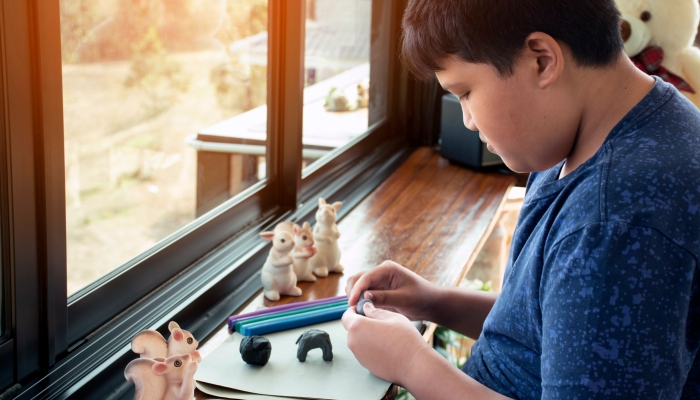5 Tips for Introducing Your Child with Special Needs to a New Caregiver

- You can help introduce your child to a new caregiver by scheduling a meet-and-greet, preparing a care plan, and fostering open communication.
- If your child has difficulty connecting with a new caregiver, try facilitating bonding activities to help them get to know each other.
- It’s recommended to have daily or weekly check-ins with the caregiver to check on your child’s progress.
As a parent, I know how challenging it can be to entrust someone else with your child’s care. It’s not just about finding someone qualified—it’s about finding someone who understands, respects, and genuinely connects with your child.
Introducing a new special needs caregiver can feel overwhelming, but you can set everyone up for success with the right approach.
While these are helpful tips for introducing your child to a new caregiver, remember to trust your gut if something seems off.
1. Prepare a Comprehensive Care Plan

One of the most important things I’ve learned about finding a caregiver is that preparation is critical. Before introducing a caregiver to your child, I recommend creating a detailed care plan.
The better informed the caregiver is about your child’s unique needs, the better equipped they’ll be to provide effective and compassionate care.
A care plan can include critical information like:
- Daily routines: Let them know when your child eats, plays, and sleeps.
- Medical needs: Provide a list of medications, dosages, allergies, and emergency contacts.
- Preferences and dislikes: List your child’s favorite songs or foods they avoid.
- Therapies and goals: Explain how the caregiver can help support their therapy goals.
Remember to share communication tips with the new caregiver, including your child’s specific communication style (e.g., sign language, picture boards, or verbal cues). Letting them know beforehand will help the caregiver interact with them effectively.
For example, if your child uses a communication device, show the caregiver how to use it. You can also create a visual schedule to help your child and caregiver.
2. Schedule a Meet-and-Greet

I recommend scheduling a meet-and-greet between your child and the new caregiver before they start. An initial meeting can familiarize your child with the person and allow you the opportunity to observe them together. It’s also best to meet in a familiar place, like your home, so your child feels comfortable.
You can also gradually introduce a new caregiver to help reduce stress and make your child feel more comfortable. For example, you can encourage the caregiver to participate in your child’s favorite activities with you present before leaving them alone.
During this initial meeting, have the caregiver observe your interactions with your child. Show them how you engage with your child during daily activities or calming moments. This helps the caregiver learn more about your child’s needs and preferences and reassures your child that the caregiver is someone you trust.
You can start with simple, shared activities like playing a game, reading a story, or going for a short walk. Then, gradually allow the caregiver to take on a more active role while you remain close by to provide support and guidance.
3. Provide Sensory Preferences and Needs

Children often have sensory preferences, which can impact their comfort and behavior, especially for children with special needs.
Sensory activities are essential for children with special needs because they help stimulate the different senses11. Benefits of Sensory Activities for Children with Autism. Erie County Care Management. https://www.eccm.org/blog/benefits-of-sensory-activities-for-children-with-autism in the brain, which are necessary for developing language and motor skills.
Help the caregiver understand your children’s sensory needs. For example, what does your child enjoy, or what do they find overwhelming? I have one child who loves soft music but gets anxious around loud noises and bright lights.
You can also provide sensory tools your child uses, such as weight blankets for calming, fidget toys for focus, or noise-canceling headphones to reduce sensory overload.
It’s also best to let the caregiver know when they are most helpful, such as during transitions or when your child feels overwhelmed.
By addressing sensory needs in advance, you can help the caregiver avoid unnecessary stress for your child and ensure a more positive experience.
4. Discuss Behavior Management Techniques

When you understand your child’s behavior, you can help ensure more effective caregiving. For example, you can share strategies for managing your child’s behavior, including their response to specific triggers.
In addition, you can teach the caregiver how to help your child calm down during challenging moments. This may include practicing deep-breathing exercises, using sensory seeker toys, or giving the child space to self-regulate.
The more information you offer your caregiver, the better they can handle difficult situations. Along those same lines, caregivers need to understand your household rules and boundaries, which helps create consistency. Remember, kids thrive on routine.
You can also tell them how you reinforce positive behavior and address discipline in ways that respect your child’s needs and sensitivities.
It can seem overwhelming, but when you set up your caregiver for success, you’ll feel confident when you leave the house.
5. Foster Open Communication

Strong communication is vital to building a successful relationship between you, your child, and the caregiver. Open communication allows for open dialogue to address concerns or challenges.
I recommend scheduling regular updates with the caregiver through meetings, phone calls, or daily notes. This allows the caregiver to seek advice and update you on how your child adapts to certain situations.
Don’t be afraid to provide feedback; let the caregiver know what’s working and what could help. Remember, positive reinforcement is frequently the key to building confidence. You’ll also want to consider caregiver fatigue and respect when they feel overwhelmed.
Finally, if your child can communicate, involve them in the feedback by asking how they feel about the caregiver. You’d be surprised at the valuable insight children can provide!
Benefits of a Caregiver for a Child with Special Needs
A dedicated caregiver can be a tremendous asset for a family with a child who has special needs. They play a vital role in supporting the child’s growth, independence, and emotional well-being while providing essential care.
Here are some key benefits of having a caregiver for a child with special needs:
- Personalized attention and care
- Professional support for daily routines
- Assistance with therapy goals
- Enhanced social and emotional development
- Relief for parents and family members
- Support for sensory and behavioral needs
While some caregivers have a high price tag, many states offer free or reduced-cost caregiver programs. For example, California offers the In-Home Supportive Services22. In-Home Supportive Services (IHSS) Program. California Department of Social Services. https://www.cdss.ca.gov/in-home-supportive-services (IHSS) program, which provides in-home assistance to eligible aged, blind, and disabled individuals as an alternative to out-of-home care. It enables recipients to remain safely in their homes.
FAQs
How do I handle a situation where my child does not seem to bond with a new caregiver?
It’s common for children to not instantly bond with a new caregiver, but there are ways to address the situation.
Here are a few tips to consider when your child doesn’t bond with a new caregiver:
- Give it time: Remember, building trust takes time.
- Observe their interactions: Observe how the caregiver interacts with your child.
- Involve your child in the process: Ask them how they feel about the new caregiver.
- Facilitate bonding activities: Help organize activities that your child enjoys.
- Address concerns: Ask your caregiver about specific challenges or difficulties they face.
- Trust your instincts: Sometimes, you know when a caregiver isn’t the right person for your child.
How can I monitor my child’s progress and well-being with a new caregiver?
You can monitor your child’s progress with a new caregiver by:
- Having daily or weekly check-ins.
- Observing behavior and emotional changes in your child.
- Establishing measurable goals.
- Making unannounced visits.
- Using technology (with the caregiver’s consent).
What are signs that the caregiver is a good fit?
A good caregiver will show patience, empathy, and adaptability. In addition, you’ll notice your child gradually feels more comfortable and positively engages with the caregiver.
References
- Benefits of Sensory Activities for Children with Autism. Erie County Care Management. (n.d.). https://www.eccm.org/blog/benefits-of-sensory-activities-for-children-with-autism
- In-Home Supportive Services (IHSS) Program. California Department of Social Services. (n.d.). https://www.cdss.ca.gov/in-home-supportive-services

Related Posts

Eye Conditions and Syndromes, Visual Impairment
Neuralink Announces Plans to Restore Sight to the Blind with Brain Chip
Elon Musk’s company Neuralink has announced plans to begin human trials of its new “Blindsight” brain chip by the end of 2025.

Special Needs
5 Spring Cleaning Tips for Families of Children with Disabilities
Spring cleaning is an opportunity to create a more accessible, organized, and supportive space for your child with disabilities. Declutter, deep clean, and refresh!

Visual Impairment
The Gift of Understanding: How a Young Child Helps His Blind Father Navigate Life
When a parent is blind, it’s natural for people to wonder how their sighted child will adapt. Will they struggle to understand their parent’s needs? Will they feel burdened by...